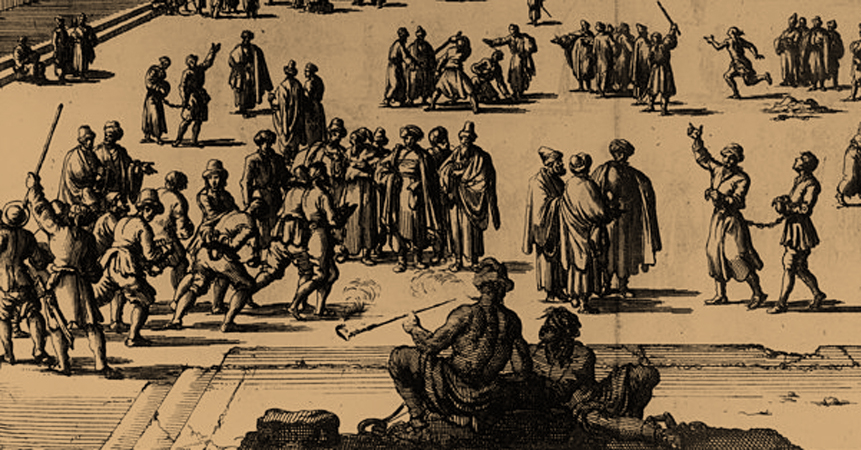This week’s post is another in the series from Father Pierre Dan, the French Trinitarian friar who took part in a diplomatic mission to Algiers in 1634, who eventually became Minister Superior of the Trinitarian Order, and who wrote Histoire de Barbarie et de ses corsaires, des royaumes, et des villes d’Alger, de Tunis, de Salé, et de Tripoly (History of the Barbary Coast and its corsairs and kingdoms, and of the towns of Algiers, Tunis, Salé, and Tripoli), a 500-plus page book on Barbary corsairs first published in 1637 and then revised and re-published in 1649—the year of his death.
Here is Father Dan on the selling of captives in Algiers.
The place where this infamous and accursed commerce in people is ordinarily conducted in Algiers is in the middle of the city. It is named the Batistan, or the Souk, and is a square marketplace with galleries on all four sides, all uncovered. It is the custom in Tunis, Salé, Tripoli, and other cities of Barbary to assemble and conduct business in markets like this. As in all of Turkey, it is in public places like these where captives are sold.
Here is how it is done.
Soon after the captives have been taken, the jailer—known as the Bâchidu—of the Bagne (the prison) in which they are kept under guard brings them to the Batistan in the presence of the Raïs, or Captains, and other officers of the vessels which captured them, who go along in order to determine how much the captives will be sold for. For purposes of the sale, there are brokers, rather like horse traders, who, well versed in this business, walk to the market along with the chained captives, shouting as loudly as they can: “Who wants to buy? Who wants to buy?” This is a thing I have seen many times in Barbary—with so much sorrow that I must admit that it brought tears to my eyes and made my heart turn cold.
It must be said here that, while Christians receive returns from their investments by lending their money at interest or by receiving annuities, in corsair cities, the barbarians invest their money in the purchase of captive Christians. They use these captives to plow their lands, cultivate their gardens, and tend the cattle in the pastures of their Masseries (their farms), or they send them to sea, or employ them in some other kind of work—all of which brings them back a profit. They do all this in the hope that they will profit from the purchase of such slaves, and that they will be able to sell them for much more than they bought them for. They promise themselves that, with time, they will receive six times more than it cost to maintain them, or they will sell them at whatever price they can get, trading them like horses.
To better sell these slaves, the brokers portray them as being far more robust and in much better condition than they actually are, so that the merchants will buy them more willingly.
The buyers look carefully at these poor Christians, who are displayed naked, or however the sellers may see fit, without any consideration of the captives’ shame. The captives must quickly obey any orders given to them. If they do not, they are beaten with sticks, which the inhuman barbarians are always quick to use. The buyers then look closely at whether the captives are strong or weak, healthy or sick, and whether they have any sores, or some shameful disease that might prevent them from working.
Next, they make the captives walk, jump, and caper about, goading them with sticks, to ensure that they do not have any ailments. They also examine the captives’ teeth, not to know their age, but to learn if they are subject to catarrhs and fluxions which could inconvenience them and render them less useful. Moreover, they look into the captives’ eyes, and even study their physiognomy and their appearance in order to draw conclusions about whether their temperament is good or bad.
But on all things, they look most carefully at the captives’ hands. They do this for two reasons. Firstly, they wish to see whether the hands are soft or callused, to determine who among them are working men. Secondly, and principally, they examine the captives’ hands to indulge in the practice of palmistry, to which they are addicted, even though such a practice is vain and ridiculous. They believe that they can recognize, by the lines and the signs that they observe, whether potential slaves will live long, whether they have signs of hidden sickness, are dangerous, or are malcontents. They even believe they can see if escape is prefigured on the captives’ palms. They so depend on these prognostications that they employ them in order to decide whether or not to risk their money in the purchase of a particular captive.
The soul these barbarian tyrants is possessed by greed, more completely than any other men in the world.
For those who may be interested….
These details about the selling of captives come from Chapter 5, Book 2 of Histoire de Barbarie. As with the other posts in this series, I translated the text above from the original seventeenth century French (I also slightly abridged parts of the original to make it clearer).
 The Travels of Reverend Ólafur Egilsson
The Travels of Reverend Ólafur Egilsson
The story of the Barbary corsair raid on Iceland in 1627
Amazon listing